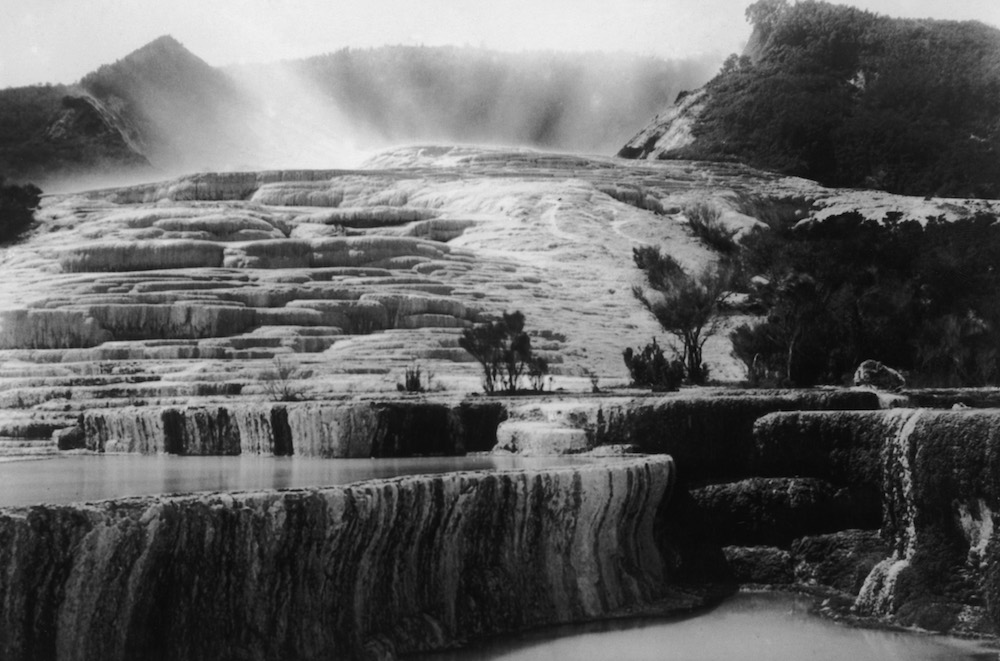New Zealand's Long-Lost Pink and White Terraces May Have Been Found

The location of a long-lost natural wonder in New Zealand has been identified, thanks to an accidentally found diary of a 19th century geographer.
The so-called Pink and White Terraces on the shores of Lake Rotomahana on New Zealand's North Island used to attract scores of adventurous tourists in the late 19th century. The massive deposits of silica sediment created by upwelling geothermal hot springs were as large as a city block and as tall as an 8-story building. Yet in 1886, within a single night, a massive eruption of a nearby volcano transformed the landscape around the lake beyond recognition and erased the natural wonder from the Earth's surface.
An independent researcher now claims he knows exactly where the terraces lie. The mystery was solved using a field diary that belonged to the German geographer Ferdinand von Hochstetter, which no one knew about until 2011. [10 Historical Treasures That the World Lost in the Past 100 Years]
"There were four eruptions of the Terawera volcano on the night of 10 June 1886," said study co-author Rex Bunn, explaining the magnitude of the disaster. "Three separate volcanic eruptions happened along a mountain peak and that was OK. The terraces survived that. But finally a hydrothermal, hot water, eruption happened and blew up the floor of the lake and that's what buried the terraces."
A huge cloud of fine volcanic ash buried the glowing surface of the terraces under a blanket of debris more than 50 feet (15 meters) thick. The shape of the lake changed and many of the surrounding landmarks, including the terraces, disappeared. Many thought the tourist magnet was destroyed by the eruption.
"The government had never surveyed the area, so the colonists had no way of knowing where [exactly] the terraces had been," Bunn told Live Science. "There was no way of getting GPS coordinates for them so it became a mystery, which continued until today."
Searching for the terraces
Bunn, an independent researcher, joined the quest to find the terraces four years ago after he had learned about work by an international research team in the area. The researchers from New Zealand's geological research institute GNS Science, Waikato University and the Woods Hole Oceanographic Institution, in the U.S., discovered pink rocks during a survey of the lake's bottom. They suggested these rosy stones could belong to the long-lost terraces.
Sign up for the Live Science daily newsletter now
Get the world’s most fascinating discoveries delivered straight to your inbox.
"This encouraged me to launch a $6 million project in 2014 to lower the lake and recover the terraces," Bunn said. "But later the same year, the group of researchers warned me to cease the efforts as they claimed they have found a newly active magma chamber, which could trigger an eruption, if I lowered the lake." [Big Blasts: History's 10 Most Destructive Volcanoes]
But in a twist of fate, Bunn was about to stumble upon a document that would change the direction of the quest. While searching for the right art for his upcoming e-book about the terraces, he came across a publication about Hochstetter, which contained hand-drawn maps of the area around Lake Rotomahana. The author of that publication, Sascha Nolden, a research librarian at the National Library of New Zealand, was also in possession of Hochstetter's field diary, which he recovered a few years earlier while working at the estate owned by the geographer's descendants in Switzerland.
"Hochstetter was commissioned by the Austro-Hungarian Empire in 1859 to join the expedition of SMS Novara to carry out research in the South Seas," Bunn said. "When they came to New Zealand, the colonial government asked him to undertake survey work on the North Island. He spent many months working on the island with his assistants and the survey included the old Lake Rotomahana and the Pink and White terraces."
However, the colonial government seems to have never received the documentation. Hochstetter returned to Europe together with his field diary, which contains 24 full pages of information about Lake Rotamahana and the Pink and White Terraces. The diary happens to be the only accurate scientific record documenting the lost natural wonder.
"I immediately saw the diary contained numerical data, which were compass bearings of various features around the old Lake Rotomahana," Bunn said. "Most of these old lake features in the diary were destroyed by the 1886 eruption, but 10 remained." ['Dear Diary': 14 Noteworthy Journal-Keepers]
In Hochstetter's steps
From these surviving bearings, Bunn developed an algorithm to reconstruct the coordinates of the land where Hochstetter stood in 1859. According to Bunn, compass bearings recorded 150 years ago need to be adjusted for today's use, because Earth's geomagnetic field has changed since the late 1800s. Subsequently, Bunn converted the data into mapping formats that could display the location of the terraces on Google Maps and other 21st-century mapping services.
Bunn said he is confident his findings are accurate. But the terraces, contrary to data from previous research, don't lie at the bottom of the lake. Rather, they are on the shore, covered by 50 feet (15 m) of volcanic deposits. Bunn is in talks with the native tribes that own the land, and he hopes to make radar and drilling surveys of the area in an attempt to recover a piece of the pink and white silicate.
"The ash [that deposited onto the terraces] was only about 150 degrees Celsius to 250 degrees Celsius [302 degrees to 482 degrees Fahrenheit] hot and it would not have hurt the terraces," Bunn said. "The melting point of silicate is between 600 and 1,200 degrees Celsius [1,112 degrees and 2,192 degrees F], so the ash would not have hurt them and that's why I am fairly confident that they lie buried under this fine ash."
The researcher hopes the long-lost wonder can be dug out and once again exposed to the eyes of the world. The hot springs that once created the terraces no longer exist. But, according to Bunn, other wonders of the world, such as the monuments of ancient Rome and Greece, are also in less-than-perfect condition and yet sensation-seeking tourists don't seem to mind.
The results of the study were published online June 7 in the Journal of the Royal Society of New Zealand.
Original article on Live Science.










